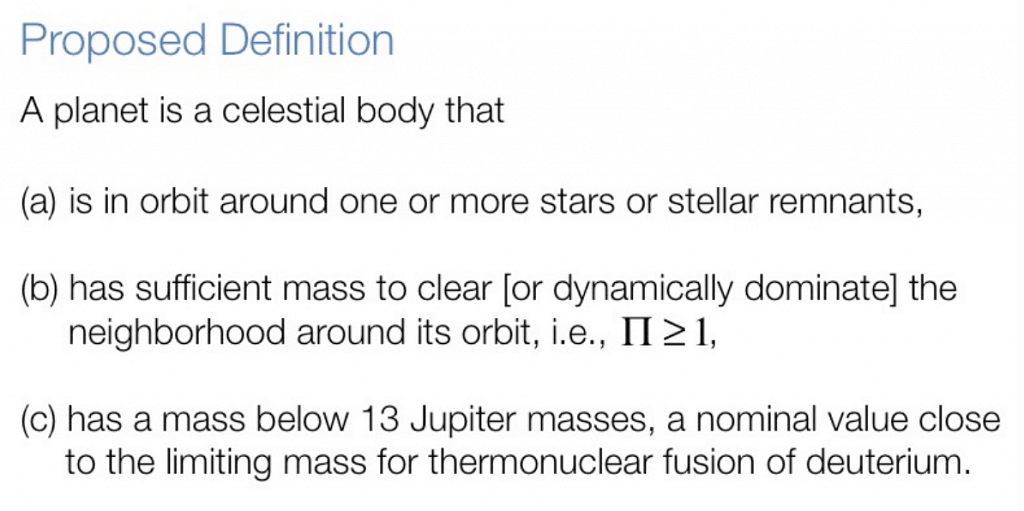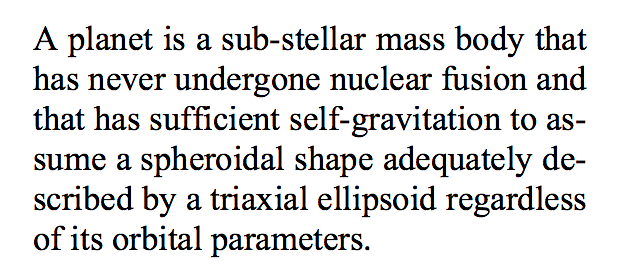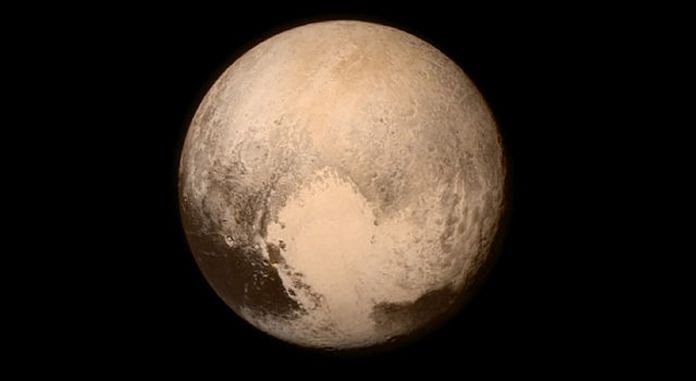In 2006, Pluto was declared a dwarf planet because of a change in the definition of the word ‘planet’ and since then a number of definitions have been doing the rounds.
Bengaluru: One of the most hotly debated topics at the Lunar and Planetary Science Conference (LPSC) 2018, being held in Texas, USA, is the definition of a planet.
If you went to school any time more than a decade ago, you would remember our nine planets: Mercury to Neptune, and Pluto. However in 2006, Pluto was “demoted” from a planet to a dwarf planet because of a change in the definition of the word ‘planet’.
The series of events that led to this redefining by the International Astronomical Union (IAU) was first the discovery of a number of small objects in the 1990s in the region beyond Neptune that’s called the Kuiper Belt. These objects, called Kuiper Belt Objects (KBOs), shared a lot of compositional characteristics with Pluto. Several astronomers unofficially stopped calling Pluto a planet, merely referring to it as the largest KBO. Then in 2005, an object called Eris was discovered and announced as the 10th planet. Astronomers thought then that it was larger than Pluto, and this strengthened the argument for demotion.
This announcement wasn’t without controversy. Eris’s discovery added fuel to the fire that was the debate on Pluto’s planetary status. The IAU assigned a group of dedicated astronomers to come up with a proper definition of a planet, which they did and announced in 2006.
The IAU definition
The definition asks for three criteria to be fulfilled for a planet:
1. It should orbit the sun.
2. It should have enough mass to hold itself together in a near-spherical shape.
3. It should have cleared the neighbourhood around its orbit.
The last point above is the clause that killed Pluto. “Clearing the neighbourhood” means that as the body goes around the sun in its orbit, it should be the gravitationally dominant object in its path. This means that not only should the body itself not be affected by another body’s gravity, there also should not be objects that are bigger or of comparable sizes coming close to it. It turns out, Pluto’s orbit is both influenced and constrained by Neptune, and it has Eris whizzing in and out of its neighbourhood. Eris has more mass than Pluto although Pluto is larger. So in 2006, Pluto was promptly reclassified as a dwarf planet, along with Eris and three other bodies.
But there were problems with this definition. For instance, IAU does not define in numbers what constitutes a planet’s “neighborhood”. Then there’s the fact that there is no constraint on the mass of a planet. Jupiter is definitely a large planet. But a body that’s more than 13 Jupiter masses is considered a brown dwarf, aka a failed star. It can’t sustain a Hydrogen to Helium reaction, but does undergo other fusion reactions in its core. So it’s definitely not like any of our eight planets. But brown dwarfs also orbit bigger stars, so are they planets? And then there’s the barycentre.
When a body orbits another, the two actually orbit each other around their centre of mass (barycentre). In typical cases, such as the earth and the moon or the sun and the planets, the barycentre is inside the larger body. But in the case of Pluto and Charon, the barycentre lies outside. This would technically make them a double-planet system. This would happen to our earth-moon system as well, because the moon is slowly moving farther and father away.
Eventually in a few billion years, earth and moon will be orbiting a common barycentre that is located outside of both of them. Does the moon become a planet then? Lastly, this definition completely ignores rogue planets, the ones that are ejected out of their orbits and thus not orbiting a star.
Several changes to the definition of a planet have been proposed through the years. The first one that was implemented was when the original planetary definition of orbiting the sun was changed to orbiting a star, in the wake of increasingly easy exoplanet discoveries.
Another definition
In 2015, another definition was proposed by astronomer Jean-Luc Margot of UCLA as shown in the image below.

The definition is clean. The first point includes planets orbiting binary stars or remains of a star like a black hole; point (b) follows “cleaning the neighbourhood” but dynamically, ie, in its physical neighbourhood while moving around, not the orbit’s neighbourhood; point (c) excludes brown dwarfs and anything bigger.
Then in 2017, a team of planetary scientists led by the New Horizon’s principal investigator Alan Stern proposed a new definition of a planet based on its geophysical properties rather than its orbital ones.

It simply states that anything that’s round and is not a star is a planet irrespective of what it orbits. With this definition, there would be a total of at least 110 planets in our solar system, including our own moon. The scientists argue that as planetary scientists, they have a more specialised knowledge of planets and moons than astronomers do. They say that differentiating between planets would be easy. “Teachers may introduce new moon planets to their students with phrases such as, “In the 2020s, NASA will send a spacecraft to study the planet Europa, which orbits around Jupiter as one of its many moons”,” states their paper.
Kevin Schlaufman’s definition
Recently again in January of this year, a fourth definition for a planet was suggested by astronomer Kevin Schlaufman at Johns Hopkins. He states that the definition of a planet should be dependent on how planets form, not how they work today. When we look at our exoplanet database, there are quite a few that are classified as planets but are way greater than 13 Jupiter masses, the limit for something to be called a brown dwarf.
He asserts that the distinction between a planet and a brown dwarf of equal mass can only be based on their internal processes that started during their formation. Jupiter follows an accretionary process where a solid core first forms and then attracts gases, billowing up like a balloon. A brown dwarf is formed in the opposite way: clouds of gases collapse under their own weight, creating enough pressure for a core to form and thus evolve into a failed star. The definition is simple and limits the upper mass of a planet to between 4 and 10 Jupiter masses. However, it requires working knowledge of the internal structure of a body before classification.
None of the ideas above can ever exist in black-and-white. All of them are broad classifications that come with their own vague territories and exceptions. Thanks to the internet and social media, ideas are discussed more openly and quickly; as astronomers and planetary scientists wage their battles on open ground.
But the debate has gained prominence once again at LPSC 2018 — organised jointly by the Lunar and Planetary Institute and NASA Johnson Space Centre — because IAU’s General Assembly is to be held again this year in August. If any of the new definitions are considered and approved, we might just get 200 new planets, maybe with our current 8 being classified as “Uberplanets.”






